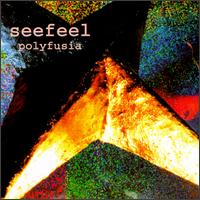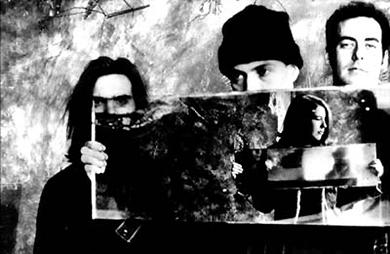
I am listening to
this as I write now so the
challenge is to convey
some of what I'm hearing. If there were words I would associate with
this
music, it would be: in space, out of space, beyond space, in time, out
of time,
beyond time, a shower of sound, water, ice melting, molecules forming.
This is
indelibly modern and not in a pejorative way, the way that modern
brings to it
all the trappings of self-conscious and often pretentious artiness.
This is
modern in an almost anachronistic way, in a way that transmits
something about
timelessness. Sound contradictory? Hmm.. that's the difficulty of this
music. No
matter when you hear it, it still contains a hint of the modern even as
it
stretches you to timelessness. OK, enough of the hyperbole. What are
the band Seefeel
about? Seefeel, of course, no longer exist, having broken up long ago.
When
they released their first songs in 1993, they were trying to use
guitars in unconventional ways, as ambience and mood instead of melody
and
pattern. They
were obviously influenced by My
Bloody Valentine, especially things
like MBV's Glider e.p. with
its explorations of sound and dance
("Glider" and "Soon" respectively) and the brilliant and rare
"Instrumental B"
that came with the first MBV album back in the late '80s. But where MBV
used
guitars to make guitar sounds, Seefeel treated their guitars with
electronics
or in some cases completely abandoned guitars for electronics in search
of the
complete blissout, moving their music further and further into the
stratosphere.
Their
music is
ostensibly
instrumental but not because it doesn't have voices; in fact many of
their songs do have voices,
but voices as fundamental instruments of
sound rather
than as the lead sound. The CD tracks are long pieces, firmly
minimalist,
with
not much to ground them except repetitive bass and percussion, based
loosely
around a dub influence. In fact, were it not for the bass/drum
backbone, the
sounds would pretty much float out into total ambience, with nothing to
hold
onto. They use guitars, sequencers, electronics, synthesizers, and
voices
to create
a brilliant mix that is utterly unlike anything else. OK, maybe that's
not
true: there were/are many others who have worked in a similar vein
(Aphex Twin,
Autechre, etc.), mining the possibilities of electronic repetition with
ethereal-sounding music that is about texture rather than narrative.
What makes
Seefeel unique is that the quality of their work is superb, on a
completely
different level than all their peers (and they didn't have many) and
more so,
of the many people who came after them. And even more a dozen years
after these
recordings, their music sounds just as out of touch and out of sequence
with
anything that you might hear in 2006.
This
particular album
is not really
an album since it's an amalgamation of two e.p.'s, the 4-song More
Like
Space and the 6-song pure,
impure, both originally released
in 1993. The title track
from the former is quite literally one of the most brilliant pieces of
music
ever recorded, nearly nine minutes of repetition that is all about
tones and
textures, slowly and imperceptibly building, ebbing, lifting up to who
knows
where.
Who
were Seefeel? They
were
basically Mark Clifford (guitars and the main guy), Sarah Peacock
(guitars,
whose lovely vocals provide the ethereal counterpoint), Daren Seymour
(bass,
radio), and Justin Fletcher (rhythm programming). They released their
first
proper album, the hour-long Quique (a
lovely phonetic invention) in 1994 that was more an extension of the
first two
e.p.s rather than a major departure, although by the t ime you get to the final
tracks on the album, it's clear that the band is now heading into
territory
that is without structure or reference to anything that one might
recognize. An
obvious reference point here is Aphex Twin, and indeed, Aphex Twin
remixed
several Seefeel tracks around this time (some of them featured on the Polyfusia compilation).
ime you get to the final
tracks on the album, it's clear that the band is now heading into
territory
that is without structure or reference to anything that one might
recognize. An
obvious reference point here is Aphex Twin, and indeed, Aphex Twin
remixed
several Seefeel tracks around this time (some of them featured on the Polyfusia compilation).
Seefeel
would
eventually release
two more full-length albums, Succour and
(ch-vox), exploring
some of the
same themes, dispensing completely with any vocal presence and moving
their
music into electronic rhythm patterns repeated ad nauseum with bits of
melodic
milestones thrown in. You had to leave your preconceptions of music
behind
basically. As far as I can tell, their last major release was in 1996
and they
last toured in 1997 and then broke up into various splinter projects.
There's
an interview with Mark Clifford done in 2003 here. A little
snippet:
Question:
When I was a junior in high school and I first got Quique, I got incredibly sick shortly afterwards, and
I remember
that a big part of my getting into the album was that it was one of the
best
records to listen to when I was feeling sick; it wasn't too obtrusive,
but it
wasn't just wallpaper either. Do you think your music has a therapeutic
quality
to it?
Clifford:
For me, making it definitely does. I can feel really low
and I then I can make music and within minutes, if I do something which
I
really like, it can just transform my mood instantly. Like I can just
go though
a complete mood swing, from being completely low to completely high. My
music
does that to me, personally, and so I would assume then that at least
some of
that comes out in the music [for other people]. I mean I know, for
example,
that Quique was used with
autistic
children. I have letters from people saying they've used it
therapeutically
with children. So I know from that point of view that it does have that
effect.
Question:
Wow. Where was that?
Clifford:
Well, the letter was from some place in Liverpool. It was
just a letter saying, "Thank you, this has been invaluable with working
with autistic children." And I know people have given birth to it. I've
had letters from people who've given birth to Quique.